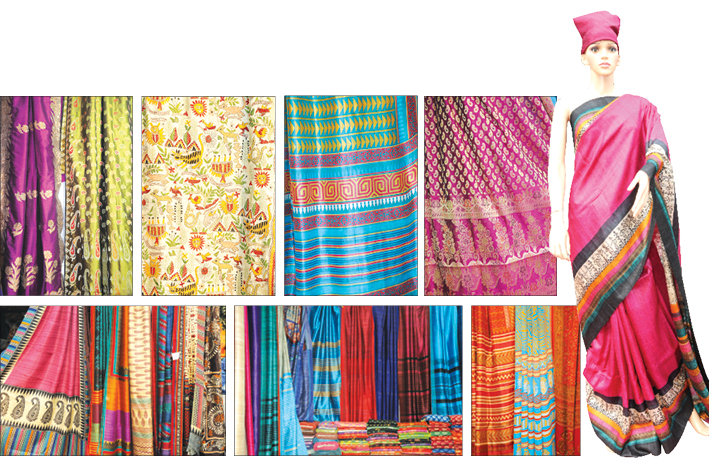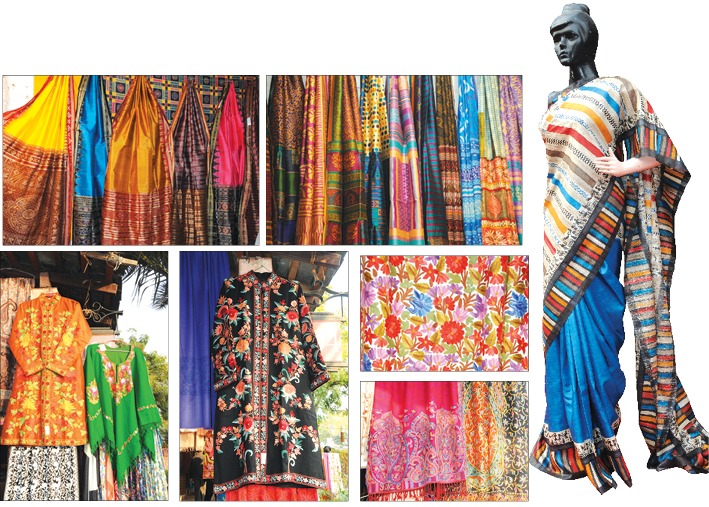In a new year marked by mourning, due to disastrously violent events against women and children that eerily echoed the Mayan Calendar’s ‘End of Days’, we are now in desperate need of inspiration and positivism. One way of renewing our values is by celebrating and supporting the inspiring positive energies of our country’s most ancient arts and crafts traditions.
India is home to some of the world’s most evolved, artistic and beautiful textile-skills, offering a remarkable range of designs and textures that expresses the nation’s vivid cultures. The current ‘Masterweavers Exposition’ at Dilli Haat brought alive this beauty and inspiration to stunning effect, cheering up the crowds of visitors. A majority of the weavers presented their finest creations here, as National Gold Medallists in their specific weaving traditions. These respected Mastercraftsmen have consistently been producing gems of weaving workmanship, which are rightful prides of India’s culture of artistry. Most of these wondrous weaving gharanas are several centuries old, bearing the complex aesthetic nuances of our civilisation.
The intricate ranges of weaving and embroidery on display literally dazzled one’s eyes with their aesthetic power. Every region of India possesses a unique and original Sari-design --- from the most simple and elegant Khadi-weaves of our tribal regions and remote villages (that were made into urban style-statements by Indira Gandhi), to the most flamboyant courtly brocades of Varanasi (that were exported to the palaces of European royalty during the
16th-C. Renaissance).
Hand-weaving is a laborious, time-consuming art. Weaving a single sari may take from seven days to a year to complete, depending upon the details of its design, fabric and colour schemes. Elaborate Temple silks and Varanasi saris, artistic treasures worthy of museum and gallery display, can take years for a master-weaver to complete.

India’s embroideries and block-printing skills are equally awesome. The intense, detailed Kantha stitches of Bengal, the intricate mirror-worked textiles of Kutch and Rajasthan, and the gorgeous crewel floral embroideries of Kashmir are lauded internationally as marvels of handicraft. All these treasures were laid out at Dilli Haat in an impressive array of artistic textile designs, painstakingly created by the humblest of Indian artisans.
I would like to highlight some leading masterworks of textile art at the Masterweavers exposition. Assam Silks, also known as Muga, bear a rare delicacy and finesse. Woven from the larvae of silkworms (endemic to Assam) that feed on ‘som’ and mulberry leaves, this silk is specially known for its glossy texture and strength. Most often this silk outlives its owner, and is passed down generations. Interestingly, the Muga yarn has a low porosity, hence cannot be bleached or dyed. This silk thereby retains its original golden hue, and can be hand-washed without any fear of fading. The other form of Assamese ‘Eri’ silk is also known as ‘non-violent silk’, as only adult open-ended cocoons of the silkworms are used. Many varieties of such lovely Assam silks were on display --- including some rare-coloured Eri silks in regal tones of Jaam-purple, red, black and gold.
A vast variety of other Indian silks were on offer – from flamboyant Bengali Santiniketani Batiks and Kantha-stitched saris, to urban Delhi boutique-prints and rarefied Tussars. Bihar contains a unique range of exceptionally subtle silk saris from Bhagalpur, that denote an elegant style with monochromatic dyes on Tussar silk. Minimalist in colourtone and pattern, marked by simple graphic striped edges on single colour-fields, these silks embody a heightened elegance. By contrast, the Tussar silk prints of Bengal are inimitably detailed, poetic and lyrical, with flowing Alpana and Tantric motifs and paisleys on spiritual tones like saffron, leaf-green and lotus-pink.

Among India’s most evolved and sophisticated silkweaves are the inimitable Ikats, Bomkais, Cuttackis and Sambalpuri Saris of Orissa. These historic saris hail from the 12th-C. period of Konarak’s Ganga Dynasty. Worn by classical Odissi dancers, their exquisitely bold jewel-colours contain a palette that is intrinsic to Orissa --- golden-yellow, parrot-green, sindoor-red, Krishna-Neelambari, bright saffron, and pearl-white. The National Award-winner Gold Medallist weaver from Bargarh village in Orissa showcased an amazing range of classic Sambalpuris – in blazing yellow, pink, turquoise and golden silks.
The Sambalpuri weave is famed for its incorporation of symbolic Orissan motifs, such as the auspicious Sankha (Conch-shell), Chakra (Chariot-Wheel), Phula (Flower), Surya (Sun-God), Matsya-Avatar (Fish), and Swarga-Dwara (Gates of Heaven). The high point of these saris is their complex tie-dyed weave art, known as Bandhkala --- a masterful rural process protected by the Indian Government’s ‘Geographical Indications’.
Among other exceptional Masterweavers’ works on display were exquisite Benarasi Brocades, created by the renowned National Awardee Salim Ahmad of Varanasi. Culling some of this art-form’s most ancient designs, Salim’s one-of-a-kind pieces were in this coveted genre’s most spectacular colour-ranges – such as Rani-pink, Jamun-purple, Feroza-blue, with elaborate Navratan multicoloured detailing on the borders and pallus. Sought after for their very fine gold and silver Zari kaarigari handwoven upon the finest silk, Benarasi saris are historically considered among the finest silks in the world. In 2009, the Benarasi weavers associations of U.P. secured Geographical Indication Rights from the Indian Government, to protect and preserve their authentic and laborious hand-weaving processes on genuine silk, that were fast being threatened by quicker machine-loom saris on inferior yarn.
Kashmiri embroidered garments on silk and wool also took pride of place at the Exposition, with their breathtaking flamboyance and cheerful colour palette. Also known as Kashida, this delightfully ornamental couture-form is as exceptionally beautiful as Kashmir itself. A European textile-historian has described its stylistics thus --- “Kashida embroideries of India have attained the ultimate limits of fantasy and incredulity, in magnificent patterns and colour-schemes, in an inspired mood aligned to the spirit of Nature.”
Among the more affordable textiles available were Delhi’s machine-embroidered dress-lengths, and stylish cutwork embossed silk scarves from Bihar – in a myriad colours to brighten one’s mood.
Samples of inspired Indian textile-art are readily available at the Haat, at reasonable rates. It is a small price to pay for Museum-worthy couture --- even more so if their creator is a Mastercraftsman of National Award-winning stature. From scarves to blouses and shawls to saris, Dilli Haat is meant to provide vast and varied choices for those who wish to dress artistically, and thus support India’s amazing textile talent.

Read More...